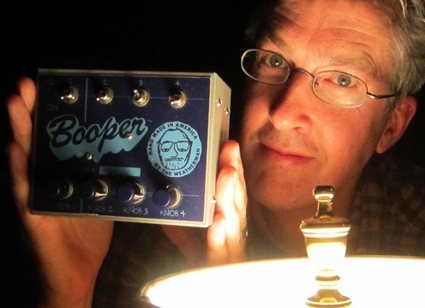 |
Mark Hosler, Negativland |
It’s hard to gauge how many of the audience saw the works that Hosler is showing here the first time around but judging from the reaction there appear to be many here for whom it is a revelation.
As Hosler cycles through the works and happenings that made him and his collaborators in the famous (or perhaps, in some instances, infamous), experimental audio collage band Negativland, those of us who have followed their work for over two decades are reminded how infectiously fun, challenging and clever these guys are. Twelve studio albums, starting in 1980 with the self-titled Negativland, two live albums, six EPs and the radio program Over the Edge, broadcast on KPFA FM in Berkeley for 32 years, are just some of their achievements. But Hosler’s presentation focuses mainly on the video works, kicking off with No Business and followed up with Truth in Advertising, Guns, Christianity is Stupid, The Mashin’ of the Christ and Gimme the Mermaid.
Between the videos, Hosler talks about the process of making the works, one very much guided by a kind of vernacular deconstruction. Hosler points out that the starting point for many of the works comes at that moment when the material they are working with reveals its own internal contradictions. Teasing this out allows the material, in a sense, to expose itself and gives them a way to move the material to its own inevitable endpoint. So, for example, Truth in Advertising takes audio material sourced from a radio call in a show called Penny Wise hosted by Bob Phillips. By manipulating and repeating certain phrases from the show, which purports to advise its listeners on saving money, they demonstrate how the program routinely promotes consumption and advertising as transparently natural. This process of denaturalisation lies at the heart of much of the work Hosler screens in the lecture.
Hosler also talks at length about the various copyright battles faced by Negativland highlighting the case brought against them by Irish mega-pop group U2 through their record label, Island Records. The case has been well documented elsewhere, notably by the band themselves in their zine, The Letter U and the Numeral 2, which was later released as Fair Use: The Story of the Letter U and the Numeral 2. Hosler’s characterisation of the album cover (a release by Negativland called U2) that sparked the controversy and subsequent lawsuit as a moment of ‘consumption disruption,’ resonates as an excellent description of many of their works.
Hosler spends some time talking about one particularly hilarious culture jam that had the somewhat satisfying outcome of exposing the cannibalistic character of much mainstream media. Unable to afford to tour their album Escape From Noise in 1987, due to a lack of time and funds, the band issued a press release claiming that the real reason they were cancelling the tour was that one of the songs from the album, “Christianity is Stupid” had played a role in a quadruple axe murder in Rochester, Minnesota. The perpetrator, David Brom, had killed his devoutly religious family, they claimed, after listening to the song. Of course, this was a complete fabrication but it didn’t stop multiple news outlets in California reporting it as fact. The ensuing media frenzy later became the source material for the band’s next album, Helter Stupid, where they relentlessly lampooned the media who had failed to fact check the press release that got the whole thing started.
This anecdote could be read as a kind of manifesto for Hosler and Negativland. Nothing is sacred. No source material is off limits. It is our right to write with the media that surrounds us like ether, that is the pharmakon of our lives. Our poison and our cure. Interestingly, this manifesto appears to have been embraced in the vernacular remix cultures that have emerged from YouTube and other media sharing sites on the web just as Hosler and the band have decided that its time to go back to where it all began—experimental electronic music.
Hosler says he preferred it when what they were doing stood outside of the mainstream and that he’s happy to leave it to others to take up the mantle of taking from the media and turning it back on itself. One can only hope that the spirit of Negativland—their wicked, playful and, yes, politically subversive spirit—remains in the mix.
Mark Hosler, Adventures in Illegal Art, ISEA2013 and Vivid Sydney, 8 June, MCA; http://www.isea2013.org/
This article first appeared on RT's ISEA2013-in RealTime blog
Lisa Gye is a Senior Lecturer in Media and Communications at Swinburne University, where she teaches, among other things, Remix Culture with Darren Tofts.
© Lisa Gye; for permission to reproduce apply to [email protected]








 back
back